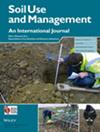葡萄园行间管理对中欧葡萄园土壤物理特性和有机碳的影响
IF 3.7
3区 农林科学
Q1 SOIL SCIENCE
引用次数: 0
摘要
葡萄园行间管理的强度和频率多种多样,取决于当地的环境条件以及葡萄种植者的态度和经验。进行不同管理的原因包括节水、控制杂草和害虫、促进生物活动以及保护土壤肥力和生物多样性。我们对奥地利东部莱萨伯格和卡农图姆地区八个地点的 16 个配对葡萄园的不同土壤覆盖管理进行了研究。为此,我们比较了中等强度(定期机械扰动)和低强度(永久绿色覆盖)的行间覆盖。我们研究了这些不同管理强度对土壤有机碳、容重、饱和及非饱和导水率、孔径分布以及上层土壤(3 至 8 厘米)渗流稳定性的影响。在永久绿化覆盖的葡萄园中,土壤有机碳和渗滤稳定性明显较高,土壤容重明显较低。饱和水力传导性、孔径分布和植物可用水量没有明显差异。这可能是由于距离上一次翻耕有长达两年的时间差造成的轻微影响。预测当地葡萄园土壤植物可用水量的回归分析也表明,质地、总有机碳和容重是合适的预测变量。这些结果表明,所研究的两种行间管理系统都能为葡萄种植者提供良好的土壤结构。有机碳含量以及与有机碳相互作用的参数仍可通过永久性植被覆盖系统得到改善,但对植物可用水量的积极影响有限。本文章由计算机程序翻译,如有差异,请以英文原文为准。
Effects of vineyard inter‐row management on soil physical properties and organic carbon in Central European vineyards
The intensity and frequency of inter‐row management in vineyards are highly diverse and depend on local environmental conditions and the wine grower's attitude and experience. Reasons for different management include water conservation, weed and pest control, biological activity promotion and soil fertility and biodiversity preservation. We studied different soil cover management in 16 paired vineyards located at eight sites in the Leithaberg and Carnuntum regions of eastern Austria. To this end, we compared inter‐rows with medium intensity (Periodically Mechanically Disturbed) and low intensity (Permanent Green Cover). We investigated the effects of these different management intensities on soil organic carbon, bulk density, saturated and unsaturated hydraulic conductivity, pore size distribution and percolation stability in the upper soil layer from 3 to 8 cm. Soil organic carbon and percolation stability were significantly higher and soil bulk density was significantly lower in vineyards with permanent green cover. No significant differences were observed for saturated hydraulic conductivity, pore size distribution and plant available water. This may be attributed to a minor effect as a result of the time lag of up to 2 years since the last tillage. Regression analysis to predict plant‐available water for local vineyard soils also showed that texture, total organic carbon and bulk density were suitable predictor variables. These results suggest that both investigated inter‐row management systems support a good soil structure for winegrowers. Organic carbon content and parameters interacting with organic carbon may still be improved with permanent vegetation cover systems; however, the positive effects on plant available water are limited.
求助全文
通过发布文献求助,成功后即可免费获取论文全文。
去求助
来源期刊

Soil Use and Management
农林科学-土壤科学
CiteScore
7.70
自引率
13.20%
发文量
78
审稿时长
3 months
期刊介绍:
Soil Use and Management publishes in soil science, earth and environmental science, agricultural science, and engineering fields. The submitted papers should consider the underlying mechanisms governing the natural and anthropogenic processes which affect soil systems, and should inform policy makers and/or practitioners on the sustainable use and management of soil resources. Interdisciplinary studies, e.g. linking soil with climate change, biodiversity, global health, and the UN’s sustainable development goals, with strong novelty, wide implications, and unexpected outcomes are welcomed.
 求助内容:
求助内容: 应助结果提醒方式:
应助结果提醒方式:


